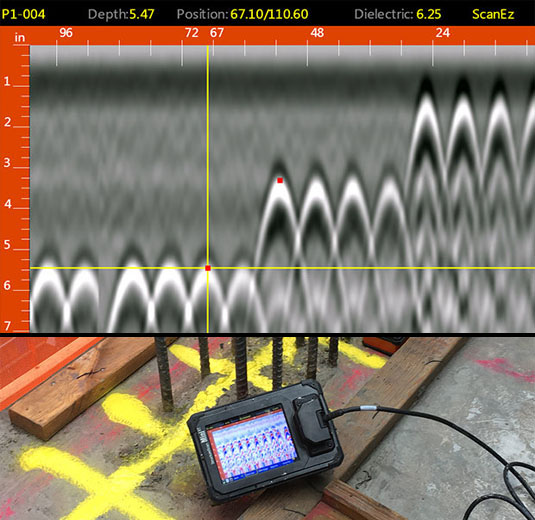Harness the Strategic Edge of Concrete Scanning for Unparalleled Task Success and High Quality Guarantee
In the realm of modern building and construction and infrastructure development, the use of concrete scanning technology has actually arised as an essential tool for making sure job success and maintaining high quality criteria. The true power of concrete scanning lies not only in its ability to boost job results however additionally in its capability to reinvent typical practices, setting a brand-new criteria for precision and effectiveness in the construction sector.
The Value of Concrete Scanning
Concrete scanning is an important action in construction jobs to ensure the security and integrity of structures. By utilizing different scanning technologies such as Ground Passing Through Radar (GPR) and electromagnetic induction, building groups can non-destructively assess the subsurface of concrete frameworks to determine prospective dangers like rebar, avenues, or post-tension wires. This details is essential for task designers, professionals, and managers to make enlightened choices and avoid expensive errors throughout the building procedure.
One of the main reasons that concrete scanning is so crucial is its ability to avoid mishaps and injuries on the building and construction website. Inadvertently reducing with a live electric avenue or damaging post-tension cable televisions can have disastrous repercussions, not just in terms of security however also in terms of project hold-ups and monetary ramifications. By carrying out thorough concrete scanning prior to any exploration, cutting, or coring activities, building and construction teams can reduce risks and develop a more secure working environment for everyone entailed.
Along with safety and security considerations, concrete scanning also plays a key role in ensuring the long-lasting sturdiness and quality of the framework. By discovering any defects or abnormalities hidden under the surface area, such as voids or delamination, very early intervention can be applied to deal with these concerns before they intensify right into more substantial troubles. Eventually, purchasing concrete scanning is an aggressive step that can save time, cash, and resources in the lengthy run, while additionally supporting the highest requirements of construction quality.
Advanced Modern Technology for Specific Results

Furthermore, 3D scanning technologies use an extensive sight of the subsurface setting by creating in-depth electronic models. These designs give valuable insights right into the structural stability of concrete elements and assist in identifying prospective weak points prior to they escalate right into major issues. By incorporating these innovative modern technologies right into concrete scanning techniques, building and construction teams can improve process, minimize project delays, and ensure the overall quality and success of the project. The accuracy and effectiveness offered by these tools add substantially to the project's success by assisting in informed decision-making and improving quality control actions.
Enhancing Task Efficiency and Timelines

In addition, concrete scanning enables groups to identify potential risks and structural weaknesses beforehand, enabling punctual removal and protecting against crashes that can thwart task timelines. The real-time information given by scanning devices promotes educated decision-making, leading to smoother coordination amongst different trades and stakeholders. This enhanced partnership lessens problems, boosts efficiency, and eventually accelerates project distribution.
Furthermore, by proactively dealing with problems through concrete scanning, building groups can stick to routines extra effectively, lower downtime, and maximize source allocation. The capability to detect surprise obstacles and validate structural honesty effectively adds to total task effectiveness and timelines, ensuring successful outcomes and customer complete satisfaction.
Ensuring Safety and Risk Mitigation

Danger reduction methods can be boosted with the comprehensive information given by concrete scanning, allowing job teams to make informed choices that lower the probability of unanticipated occurrences. Furthermore, by properly drawing up subsurface conditions, service providers can avoid expensive rework, hold-ups, and damage to existing frameworks, further adding to total job safety and security and success. Executing concrete scanning as a routine technique not just guarantees a much safer job environment however also instills self-confidence in stakeholders pertaining to the job's commitment to quality and threat monitoring.
High Quality Assurance Through Concrete Scanning
Concrete scanning plays an essential role in promoting quality control criteria within building and construction jobs. By using advanced scanning technologies such as Ground Penetrating Radar (GPR) and Concrete X-ray, project managers and engineers can ensure the integrity and top quality of concrete structures. Via concrete scanning, possible problems, such as spaces, fractures, or reinforcing bar blockage, can be discovered non-destructively, permitting timely treatments to keep the structural integrity of the project.
Quality control with concrete scanning not only assists in identifying existing concerns however also enables aggressive actions to stop future troubles that can jeopardize the security and long life of the structure. By conducting detailed scans at essential stages of construction, teams can confirm the accuracy of architectural plans, verify the positioning of important aspects, and address any inconsistencies quickly. This aggressive approach minimizes rework, reduces costly hold-ups, and inevitably brings about the distribution of top article notch, long lasting structures that meet or go beyond sector requirements.
Conclusion
In conclusion, concrete scanning plays an essential role in ensuring task success, quality, efficiency, and safety guarantee. The critical side given by concrete scanning enables for aggressive threat mitigation and boosts overall task administration.
In the world of modern construction and framework growth, the utilization of concrete scanning innovation has actually emerged as a critical device for guaranteeing project success and preserving quality standards. By integrating these advanced technologies right into concrete scanning practices, building teams can enhance workflows, minimize project hold-ups, and guarantee the overall high quality and success of the project.Offered the critical nature of job efficiency and timelines in building management, the emphasis now changes in the direction of guaranteeing safety and security and mitigating threats within the project setting.Concrete scanning plays an essential function in promoting quality guarantee requirements within construction projects. By using advanced scanning innovations such as Ground Passing Through Radar (GPR) and Concrete X-ray, task supervisors and designers can make certain the stability and top quality of concrete structures.
Comments on “Comprehensive Guide to RainierGPR Concrete Scanning Techniques”